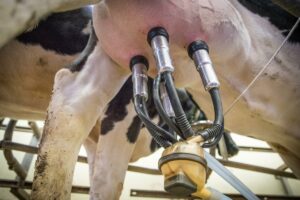Maria Villagrasa
Almost all animal physiological and behavioral functions are rhythmic, including hormone secretion patterns, sleep and wakefulness cycles, metabolism, and core body temperature. These daily rhythms evolved as a strategy among animals to coordinate internal systems and synchronize them with the environment.
If they persist in the absence of environmental signals, they are called circadian rhythms (i.e. 24-hour cycles of biochemical, physiological, or behavioral processes). In mammals, these circadian clocks are regulated hierarchically, with the main circadian clock located in the hypothalamus. In addition, there are peripheral clocks in all organs.
Metabolic function and circadian clocks are tightly connected and mutually regulated, as a result, clocks drive metabolic processes and various metabolic parameters affect in turn these clocks. Dairy cattle show circadian rhythms of dietary behavior; plasma concentrations of metabolic hormones and metabolites (plasma glucose, non-esterified fatty acids, hydroxybutyric acid, and urea nitrogen).
In addition, the duration of the photoperiod affects milk production. Exposure to a long-day photoperiod during lactation increases milk production without initially altering feed intake, while exposure to a short-day photoperiod during the dry period improves post-lactation performance.
The objectives of a study (Suarez-Trujillo et al., 2020) were to determine the effects of exposure to chronic changes in the light-darkness cycle on the circadian rhythms of cows during the last five weeks before calving. Among the parameters measured were body temperature, melatonin, behavior (feed intake and activity), blood glucose concentrations, non-esterified fatty acid (NEFA), hydroxybutyric acid, insulin, and milk production and composition.
A total of 32 Holstein multiparous cows were assigned to 1 of 2 treatments:
- Control (CTR): the cows were exposed to 16 h of light and 8 h of darkness (the lights were turned on at 04:30 h, and off at 20:30 h);
- Cycle change (CC): the cows were exposed to 16 h of light and 8 h of darkness, but the light phase was advanced 6 h every 3 days. Each cow was exposed to at least 10 light changes during the treatment (35 to 3 days before calving).
The cows were dried up 60 days before the day of expected calving and stayed in individual pens from day 35 before delivery to 3 days before delivery when they were exposed to photo-phase treatments. From three days before delivery until three days after, cows in both treatments were housed in the maternity pen and exposed to control lighting (16 h of light and 8 h of darkness).
Within three days in milk, cows were moved back to individual cubicles, where for 15 days they were exposed to control lighting. From days 23 to 9 before delivery and on day 5 after delivery, blood samples were drawn every 4 hours for a total of 48 hours. Body temperature was recorded for 48 hours on days 23 and 9.
Under natural conditions, circadian rhythms are synchronized with regular cycles of light and darkness of 24 hours. In this study, the body temperature of CTR cows was adjusted to a circadian rhythm between days 23 and 9 before calving, peaking approximately 2 hours after the start of the dark phase in both sampling periods (22.38 h and 21.50 h, respectively).
On the other hand, changes in the natural cycle of light and darkness can alter circadian clocks which is what was observed in the CC group so that, although the temperature peak was similar between 23 and 9 days before delivery, it occurred at different hours compared to CTR cows (03:22 h and 04:22 h, respectively).
The change in the timing of the temperature rhythms of CC cows probably reflected an adjustment of the circadian synchronization system to other reliable signals that occur regularly, which in this study was the time of the first daily exercise at 04:30 h.
There was a difference of 0.5°C in between the peak and the valley of body temperatures in CTR cows, while the difference for CC cows was 0.3°C, which supports the existence of a buffering or attenuation of circadian rhythms in the CC compared to the CTR treatment.
Resting activity
The total rest time was longer during pre-calving than post-calving periods. Cows on CC rested more each day than CTR cows (700 vs. 650 min) and the number of rest episodes over the course of the day was also higher in CC cows (11.8 vs. 10.2) but its duration was shorter than in CTR cows (61.8 vs. 67. 6), and this effect was more pronounced pre-calving.
Significant differences in total daytime resting time in both treatments, with longer dark phase resting time (16. 00–05. 00 h) than that of the light phase (05. 00–16. 00 h).
Light inhibits melatonin synthesis and the changes in the circadian rhythms of plasma melatonin reflect this response in CTR cows, with levels almost undetectable during the light phase. In contrast, CC cows adjust to the rhythms of 24 h only at three weeks before delivery.
Treatment did not affect DM intake
Treatment did not affect DM intake (16.4 kg/d). Feed intake was higher in the postpartum than in the prepartum period in both treatments (15.7 and 15.5kg/d for CTRand CC, in the prepartum period; 18.7and 18.3 kg/d for CTR and CC, in the postpartum period).
The average blood glucose concentrations were higher in prepartum than postpartum in both treatments (CTR: 78.5 and 68.0 mg/dL in pre and postpartum, respectively; CC: 73.9 and 62.8 mg/dL in pre and postpartum, respectively). Treatment had a general effect on blood glucose, it was reduced in CC cows relative to CTR cows (69.6 vs. CTR. 73.1 mg/dL).
Concentrations of hydroxybutyric acid and NEFA were higher in the postpartum period. There was no treatment effect on both compounds in blood at 06.00 h of sampling. The concentration of NEFA was higher in the morning than in the afternoon for both treatments (CTR: 0.72 and 0.48 mEq/mL in morning and afternoon, respectively; CC: 0.89 and 0.69 mEq/mL in morning and afternoon, respectively).
Treatment did not have a general effect on insulin concentrations, but on the day of delivery, CTR cows had a higher concentration of insulin than CC cows.
Cows with attenuated circadian rhythm produce more milk
There was a general effect of treatment on milk production by 60 days in milk: CC cows produced more than CTR cows (43.10 vs. 40.30 kg/day). There were no differences in fat (4.79%) and protein (3.08%) percentages, but the daily fat yield was higher in CC cows (1.89 vs. 1.67 kg/day).
Attenuation of circadian rhythms in CC cows may affect circadian clocks specific to the mammary gland so that the gland tissue proliferation is increased prior to delivery and is reflected as an increase in milk production during lactation.
These findings suggest that attenuation of circadian rhythms is likely to result in a more consistent production of hormones and metabolites supporting the onset of milk production.
Reference
Aridany Suarez-Trujillo, Grace Wernert, Hui Sun, Tabitha S. Steckler, Katelyn Huff, Shelby Cummings, Jackeline Franco, Rebecca N. Klopp, Jonathan R. Townsend, Michael Grott, Jay S. Johnson, Karen Plaut, Jacquelyn P. Boerman, and Theresa M. Casey. 2020. Exposure to chronic light–dark phase shifts during the prepartum nonlactating period attenuates circadian rhythms, decreases blood glucose, and increases milk yield in the subsequent lactation. J. Dairy Sci. 103:2784–2799.
© 2020 Dairy Knowledge Center. All Rights Reserved.











